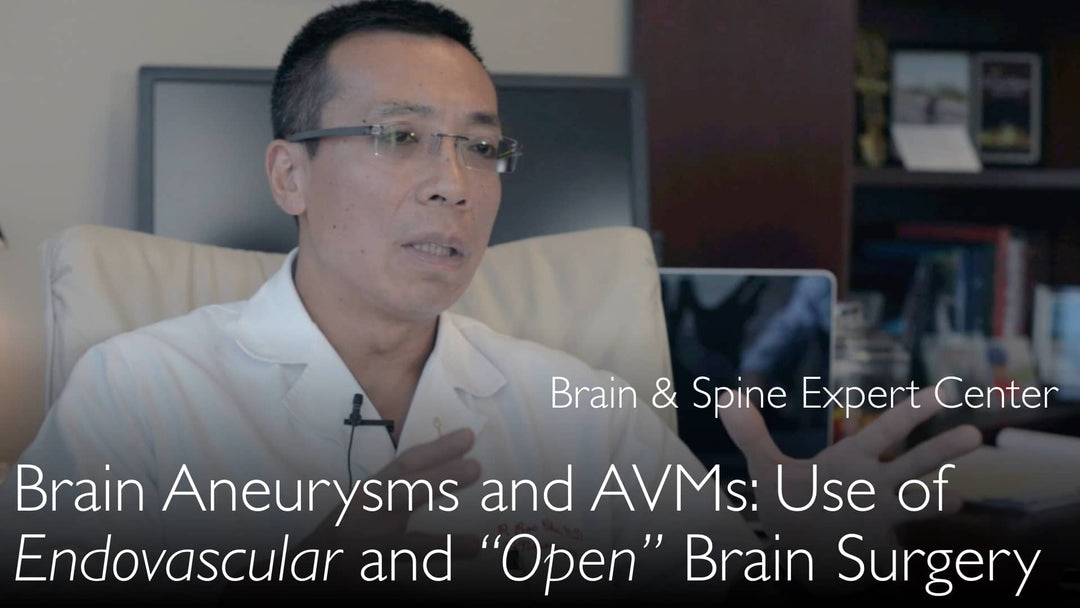Leading expert in cerebrovascular neurosurgery, Dr. Peng Chen, MD, explains how the combination of open brain surgery and endovascular intervention provides superior treatment options for complex conditions like aneurysms and arteriovenous malformations, leading to better patient outcomes, lower procedural risks, and more comfortable recovery times.
Combined Open and Endovascular Neurosurgery for Cerebrovascular Disease
Jump To Section
- Benefits of a Combined Neurosurgical Approach
- Evolution of Cerebrovascular Surgery
- Advantages of Endovascular Neurosurgery
- Importance of Unbiased Treatment Recommendations
- Optimal Patient Selection for Combined Treatment
- Future of Cerebrovascular Care
- Full Transcript
Benefits of a Combined Neurosurgical Approach
Patients with complex cerebrovascular diseases benefit most from a neurosurgeon trained in both open brain surgery and endovascular intervention. According to Dr. Peng Chen, MD, this dual expertise allows for a comprehensive evaluation of all treatment options. A surgeon capable of performing both procedures can offer the most beneficial result with the least risk, tailoring the approach to the individual's specific condition.
This combined skill set is particularly valuable for conditions like brain aneurysms, arteriovenous malformations (AVMs), and other vascular abnormalities where a hybrid approach may yield the best outcome.
Evolution of Cerebrovascular Surgery
Open vascular neurosurgery has been performed for several decades, with techniques now highly refined. Dr. Peng Chen, MD, notes that these traditional open procedures successfully treat many complex cerebrovascular diseases. The field represents a foundation of proven surgical interventions with established long-term results.
In the interview with Dr. Anton Titov, MD, Dr. Peng Chen, MD, emphasizes that open surgery remains a crucial component of comprehensive cerebrovascular care, especially for cases where direct visualization and access are necessary.
Advantages of Endovascular Neurosurgery
Endovascular neurosurgery has developed into an extremely robust subspecialty over the last 20 to 30 years. Dr. Peng Chen, MD, highlights that this minimally invasive approach offers very attractive benefits for patients. The procedures typically involve shorter recovery times, greater patient comfort during the recovery period, and generally better tolerance of the intervention itself.
While not completely risk-free, endovascular techniques fundamentally aim to minimize procedure risks compared to traditional open surgery. Dr. Peng Chen, MD, explains to Dr. Anton Titov, MD, that the difference in recovery experience between open cerebrovascular surgery and endovascular neurosurgery is significant for many patients.
Importance of Unbiased Treatment Recommendations
Neurosurgeons with dual training in both open and endovascular techniques can provide less biased recommendations. Dr. Peng Chen, MD, emphasizes that these specially trained physicians are better equipped to evaluate all options objectively. They can determine whether a patient would benefit more from open surgery, endovascular intervention, or a combination of both approaches.
This comprehensive perspective ensures patients receive the overall best treatment option rather than being limited to whatever single procedure a surgeon happens to specialize in.
Optimal Patient Selection for Combined Treatment
The combination of open and endovascular treatment modalities provides the best choice for optimal patient outcomes. Dr. Peng Chen, MD, explains that as cerebrovascular neurosurgery progresses, this integrated approach delivers the most beneficial results. Patients with particularly complex cerebrovascular disease represent the ideal candidates for evaluation by a dually-trained neurosurgeon.
During his discussion with Dr. Anton Titov, MD, Dr. Chen noted that this comprehensive capability allows for treatment strategies that might involve staged procedures or simultaneous combined approaches that wouldn't be possible with a single-specialty surgeon.
Future of Cerebrovascular Care
The continued development of both open and endovascular neurosurgical subspecialties working in conjunction promises better patient care. Dr. Peng Chen, MD, anticipates that as times goes on, the integration of these techniques will continue to improve outcomes while minimizing risks. The field is moving toward more personalized treatment plans based on each patient's unique vascular anatomy and medical condition.
This evolution in cerebrovascular care ensures that patients will have access to increasingly sophisticated treatment options that leverage the strengths of both surgical approaches.
Full Transcript
Dr. Anton Titov, MD: You are one of the few neurosurgical specialists who combines very deep and thorough training in endovascular methods as well as in open brain surgery. Could you speak about what kind of patients benefit most from such rare and superior expertise?
Dr. Peng Chen, MD: At this point, cerebrovascular neurosurgery has developed into a very complicated cross-role. Open vascular surgery has been performed for several decades, and the techniques at this point are very refined. We are able to treat a lot of complex cerebrovascular diseases very successfully.
However, over the last 20 to 30 years, the entire endovascular field developed from almost nothing into an extremely robust subspecialty. One of the most meaningful things about endovascular neurosurgery is that it brings very attractive, less complicated post-procedure recovery time. Patients are more comfortable with recovery; they tolerate procedures easier.
We also fundamentally want to bring down to the minimum the risk of a procedure. I don't think we can call endovascular neurosurgery "minimal risk," but at the same time, we do see the difference in terms of recovery between open cerebrovascular surgery and endovascular neurosurgery.
So at this point, both subspecialties are developing in conjunction together and are able to provide patients different options in terms of treatment and treatment modalities. The most meaningful thing is that, as things progress, we've seen the combination of two types of treatment modalities to give us the best choice to give a patient the most beneficial result.
It gives the best outcome, least risk, and as time goes on, it will be much better. When surgeons have a better background and are capable of handling extremely complicated open surgery and also able to handle quite sophisticated endovascular treatment, they're typically able to be less biased to provide patients with a good recommendation.
They also give them what potentially is the overall best treatment option. For a patient with cerebrovascular disease, it would be one of the best choices to see this physician who can do both endovascular and open brain surgery.




